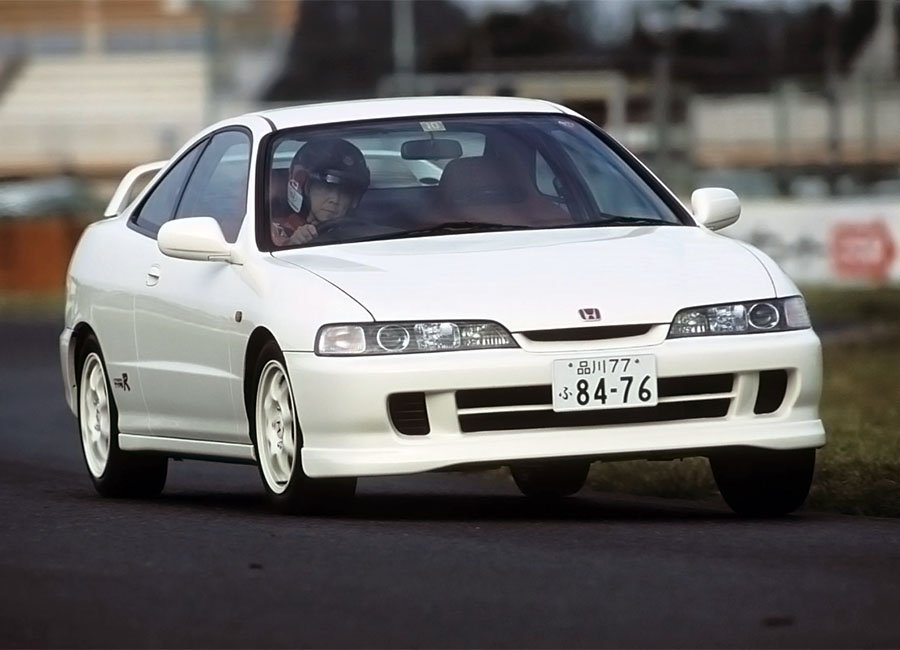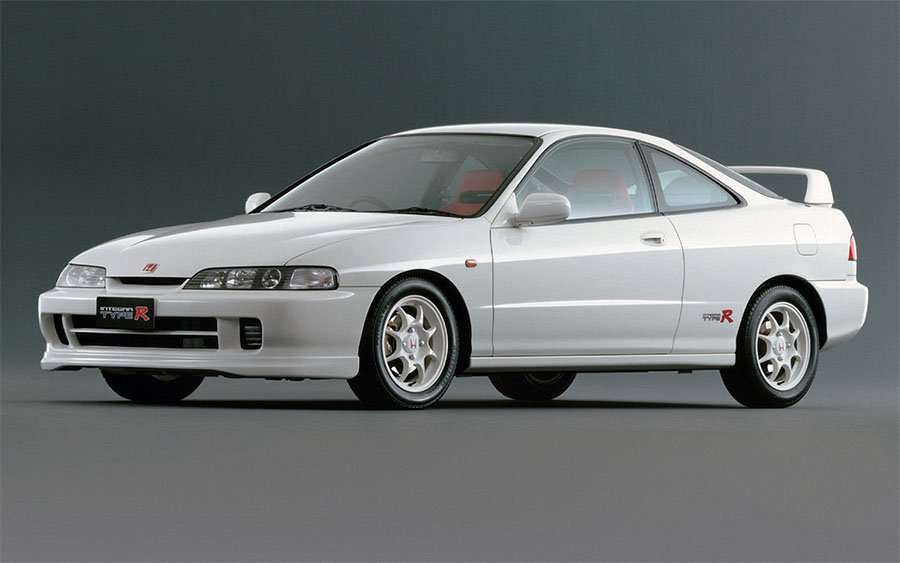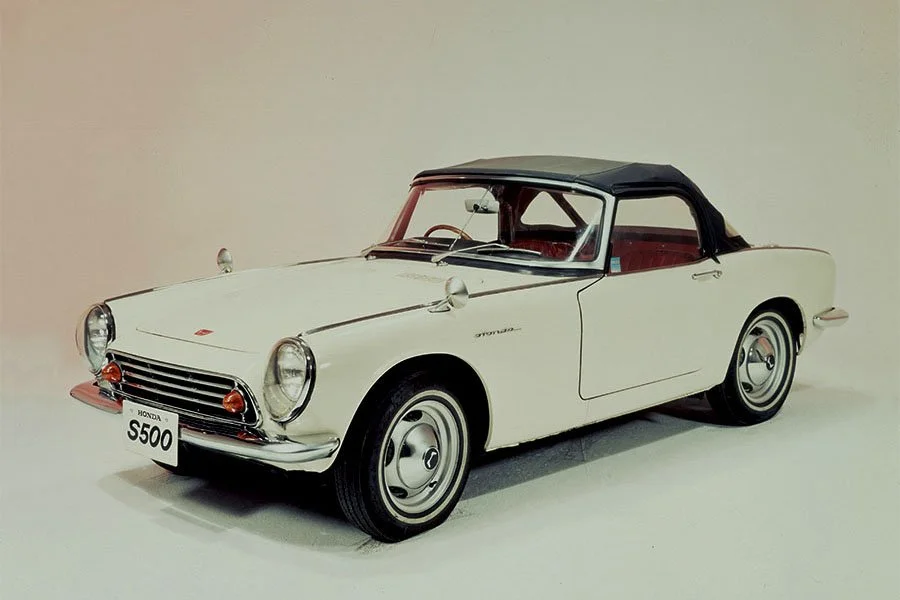Guide: Type R + Everybody - a Historical & Technical Appraisal of the Honda Integra DC2 Type R
/BACKGROUND
Having made a breakthrough into the automotive market with the first generation Civic in 1972, Honda went from strength-to-strength. By the mid 1980s, the company had become one of the biggest motor manufacturers in the world.
The Integra arrived in 1985 as Honda’s upper mid-range model.
After several years of strong sales, a second generation Integra followed in 1989 and brought with it Honda’s first VTEC motor.
The VTEC system (Variable Valve Timing and Lift Electronic Control) was devised to improve volumetric efficiency by altering the engine’s camshaft profile. It provided high performance at faster engine speeds, but enabled lower fuel consumption at slower engine speeds. The result was a range of high revving motors that effectively offered a split personality according to the whim of the driver.
The third generation Integra was launched in 1993. It was offered as a front-wheel drive three-door Hatchback or four-door Sedan with a range of single and dual overhead camshaft four cylinder engines ranging in size from 1.6 to 1.8-litres.
The third generation Integra’s most distinctive feature was its front end styling; Honda’s in-house design team had come up with a bug-eyed four-port look that ultimately proved unpopular in the firm’s home market.
As a result of this unpopularity, Integras built for the Japanese Domestic Market (JDM) from the autumn of 1995 received a facelift with slim single-piece headlights that were broadly similar to the type that had been fitted to the second generation variant.
Meanwhile, back in 1992, Honda had launched a new Type R version of the fabled NSX. The light weight NSX Type R was created for those customers that wanted a more driver focused machine. It came with uprated suspension, a blueprinted engine and a simplified interior.
Although the NSX Type R was not a huge seller, Honda subsequently thought they may be able to apply some of the Type R magic to other models in the range.
First to arrive was an Integra Type R launched in September 1995.
Two different variants were offered: the three-door DC2 and the heavier five-door DB8 (covered separately). Both were significantly enhanced over the previous Integra flagship: the 178bhp Si.
Production began in October 1995 and, as per the NSX Type R, the DC2 was initially offered exclusively as a JDM special.
CHASSIS
Compared to other iterations of the third generation Integra, the Type R received a uniquely strengthened bodyshell with extra spot welds, reinforced rear shock towers and beefed up subframes.
The wheelbase was an unchanged 2620mm.
Suspension was via double wishbones all round.
To improve handling, the Type R came with shorter and stiffer springs, special dampers and uprated bushes. Aluminium strut braces were added at either end along with thicker anti-roll bars.
The rear wheels were given larger, stiffer bearings for better camber control.
Bigger brake discs were fitted to enhance stopping power; the fronts had a 262mm diameter and were ventilated while the backs were solid with a 226mm diameter.
The Integra’s Anti-lock Brake System was re-tuned specifically for the Type R.
Power steering was fitted as standard.
New 6 x 15-inch super light alloy wheels were normally painted Championship White or Gunmetal and originally came shod with Bridgestone Potenza tyres. Track dimensions were 10mm wider at the front (1480mm compared to 1470mm).
A regular 50-litre fuel tank was located underneath the rear seat.
ENGINE / TRANSMISSION
At the heart of the Type R was a specially developed B18C version of Honda’s B-series engine.
A transversely-mounted and naturally aspirated inline ‘four’ with an aluminium alloy block and head, these motors ran dual overhead camshafts, four valves per cylinder, wet-sump lubrication and Honda’s famed VTEC vraiable valve timing that hydraulically switched the cam profile at a fixed point in the rev-range (in this case at around 6000rpm).
The hand-built B18C motors used in the Type R came with an array of special features to include a wider hand-polished and ported intake manifold, a free-flow big-bore exhaust, high compression molybdenum-coated pistons with extra wrist-pin lubrication paths and lightweight hand-torqued connecting rods.
There were also high-lift camshafts, lightweight thin-stem valves, larger throttle bodies and a balanced eight-counterweight crankshaft with trick metallurgy to increase the bend-fatigue limit by 25%.
A lighter flywheel and supplementary oil cooler were fitted together with the latest version of Honda’s PGM Fi fuel-injection system.
Displacement was the familiar 1797cc thanks to a bore and stroke of 81mm and 87.2mm respectively.
With a compression ratio of 11.1:1, the Type R pumped out 197bhp at 8000rpm (with an 8600rpm redline). At 104bhp per litre, it was one of the most potent normally aspirated four cylinder engines seen thus far. However, the downside was a lowly 133lb-ft of torque developed up at 7500rpm.
The Type R’s formidable little engine was hooked up to close-ratio five-speed manual gearbox that delivered the power through a torque-sensitive helical limited-slip differential.
BODYWORK
As per the Type R NSX launched three years earlier, Honda’s hot new Integra was equipped with a number of cosmetic enhancements that instantly marked it out as something special.
The front bumper was more aggressively contoured and had a pronounced chin spoiler around each corner. At the back was a massive basket handle wing to equalise downforce. The new aero addenda combined to reduce lift by 30%.
To save weight, Honda fitted a thinner windscreen and did not install a rear wiper.
Red-backed Honda badges like those fitted to the NSX Type R were used at both ends. Type R graphics were added to the rear sills and tail fascia.
As these cars were only initially sold in the Japanese Domestic Market, they were built with the arguably more attractive twin headlight configuration as opposed to the four port design subsequently used in most other markets.
Body panels were a mixture of steel and plastic composite.
INTERIOR
Inside, special high-backed Recaro sports seats were trimmed in bright red fabric as per the NSX Type R. Black fabric upholstery was available by request.
There was also a new non-airbag Momo three-spoke steering wheel complete with leather rim and red stitching.
Other unique equipment included a 10,000rpm rev counter, a titanium gear knob and faux carbonfibre inserts on the centre console and doors. One such insert was fitted in place of the audio system and oddments tray that were fitted to regular Integras.
To lessen weight, the Type R came with greatly reduced sound insulation. The vanity mirrors and cover for the spare wheel (mounted in the trunk) was also ditched.
Electric windows and mirrors were standard. Equipment not available included a sunroof, cruise control and a rear wiper.
As per most Japanese cars of this era, the cockpit had a liberal quantity of soft-touch black plastic.
Housed in the oval instrument binnacle were large read outs for engine and road speed flanked by smaller gauges for water temperature and fuel. Mounted centrally at the top of the dash was the housing for a digital clock. Further down were a pair of air vents, a bank of switches and the controls for the heating / ventilation system.
OPTIONS
Honda initially offered the Integra Type R in a choice of four exterior colours: Championship White, Flamenco Black Pearl, Vogue Silver Metallic and Milano Red.
Customers could also have their car fitted with air-conditioning and a CD audio system.
For those who wanted the lightest possible specification, the power steering and anti-lock brake systems could be deleted along with the centre console and clock.
WEIGHT / PERFORMANCE
Despite its beefed up bodyshell, thanks to those various weight-saving measures, the Type R tipped the scales at 1060kg which was about 40kg less than most other Integras.
Top speed was 145mph and 0-62mph took 6.2 seconds.
Although it took the VTEC kicking in at around 6000rpm to unleash the car’s full performance, the DC2 was considered one of the best front-wheel drive hot hatches of its era.
USA VERSION
For the 1997 model year (available from October 1996), the DC2 was offered in the USA and became the first Honda Type R officially sold outside of Japan.
The US version used the Rest of World four port headlight arrangement, a lower 10.6:1 compression ratio and a higher 8700rpm red line. The VTEC activated at around 5700rpm as opposed to 6000rpm.
New equipment included standard (non Recaro) sports seats (trimmed in charcoal fabric with red stitching), a centre armrest, a four-spoke airbag steering wheel and a black leather gear knob (also with red stitching).
The US version was branded as an Acura (Honda’s luxury and performance division for North America).
Just one colour was available, Championship White, and the only option that could be specified was air-conditioning (to be fitted by the supplying dealer).
The Acura Integra Type R was discontinued in late 1998 (for the 1999 model year) but was subsequently re-introduced for the 2000 model year (when it could also be ordered with new Phoenix Yellow paint).
REST OF WORLD VERSION
Honda also made the decision to officially offer the Integra Type R in many of their other export markets for the 1997 model year.
These cars used the four port nose instead of the JDM front end and were only available in Championship White. However, compared to the US version, the nosecone had a re-shaped intake aperture (without the original horizontal divider), subtly reworked portholes and new indicators. The embossed INTEGRA script was moved from alongside the left-hand inner headlight to alongside the left-hand side of the licence plate. There was also a new vented rear bumper.
1998 VERSION
For the 1998 model year (available from October 1997), Honda made a number of changes to the Type R’s specification.
The original 15-inch wheels were replaced with new 16-inch diameter rims in the same style as before.
The front disc brakes were also enlarged; they went from a 262mm diameter to a 282mm diameter.
To provide more torque lower down the rev range, Honda fitted a higher final drive ratio and a new new four-to-one exhaust manifold. These changes resulted in peak torque now being developed at 6200rpm as opposed to 7500rpm.
Cosmetically, all versions of the 1998 DC2 now came with the vented rear bumper.
Inside, Honda fitted a chunkier version of the three-spoke Momo steering wheel (once again with a black leather rim and red stitching).
2000 VERSION & TYPE RX
In October 1999, Honda released a further updated DC2 for the 2000 model year.
Changes included a revised intake camshaft, more finely balanced driveshafts, new shocks and some minor cockpit modifications.
Flamenco Black Pearl was replaced by Nighthawk Black Pearl. A previously unseen colour scheme was added to the range as well: Phoenix Yellow with matching yellow front seats.
Finally, a new variant known as the Type Rx was introduced for this final year of production.
The Type Rx came with electric folding mirrors, blue tinted carbonfibre-style cockpit inserts and an audio system fitted as standard.
END OF PRODUCTION
The DC2 Type R was produced from October 1995 to October 2000 and remained on sale until early 2001.
Although exact production figures are not currently available, we know around 25,000 units were built for the Japanese Domestic Market and just under 4000 for the USA. An additional few thousand units would also have been produced for other markets (to include 500 for the UK).
Text copyright: Supercar Nostalgia
Photo copyright: Honda - https://global.honda/












































